Best Shoes to Help Treat Foot Drop in Children – Let’s Improve Your Child’s Walking Gait
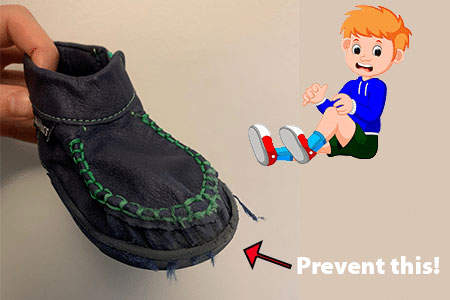
When children drag their toes on the ground when walking that might be a sign that they have a condition called foot drop. If your child has been diagnosed with foot drop then you need to look for shoes to hold your child’s feet in the normal position and prevent your child from falling. This is quite a complex subject but my goal is to explain it in a simple way so parents can understand what they might be dealing with and how to treat this condition with the correct types of shoes.
Are Your Child’s Shoes Scuffed at the Front?
When this happens, most parents assume that the shoe is made from low-quality materials, when in fact it’s a sign that children are dragging their feet when walking. For instance, take a look at the image below. This shoe has been worn for only two weeks. Do you notice the wear and tear on the front part of the shoe?
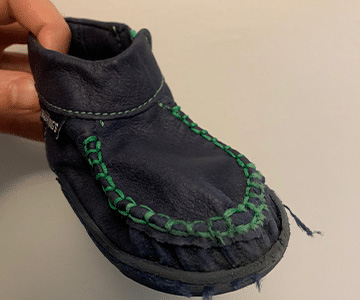
Take a closer look at the green stitching on the top part of the shoe as it looks new and in perfect condition compared to the stitching on the front part of the shoe. This is a clear sign that children drag their feet when walking:

How to Find Out if Your Child is Dealing with Foot Drop?
Children with foot drop experience weakness when attempting to lift their foot off the ground, which causes them to involuntarily drag the toes of the affected foot (it can happen in both feet) while attempting to walk. What happens is that to compensate for this dragging, children tend to lift their legs higher than normal when taking a step.
What Causes Foot Drop in Children?
Your medical professional will help you figure out whether your child’s muscles are simply not strong enough to lift the foot and toes and whether there is an underlying problem that is affecting the nerves or muscles. Foot drop is associated with numerous disabilities including cerebral palsy, stroke, spinal cord injury, and traumatic brain injury.
How to Treat Foot Drop in Children – The Most Effective Way!
With early detection and treatment, foot drop can be successfully treated in most children. I have helped several children with foot drop find the correct pair of shoes and I believe I can help your child too. While there are several treatment options, I have found that the least invasive and the one I am most experienced with involves wearing the correct type of shoes and orthotics, followed by physical therapy.
When treating foot drop in children I suggest the following 3 step approach:
- Supportive shoes with substantial outsoles and firm heel counters to hold your child’s feet in the normal position.
- Full-length orthotics or ankle brace to aid in walking and prevent tripping.
- Physical therapy to strengthen the muscles of the leg and foot.
The goal is to find a pair of shoes and orthotics that can support the structure of the feet as needed and help your child redevelop strength and control.
What Makes the Shoes I Recommend Effective for Foot Drop?
1️⃣ Substantial Outsoles: This feature is going to help cushion and support your child’s feet every time it impacts the ground. Shoes with substantial outsoles will also help keep your child’s feet in the normal position.
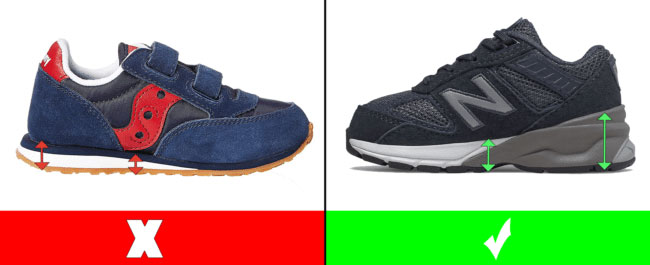
2️⃣ Firm Heel Counters: This feature is going to support and protect your child’s ankles and help keep your child’s feet in the normal position. Always press on the back part of your kids’ shoes and make sure it feels firm.

3️⃣ Extra Depth: This is a key feature if your child needs to wear an AFO or an orthotic with his/her shoes. Shoes with extra depth allow the AFO or the orthotic to fit deeply inside the shoes, providing better comfort for your child’s feet. When fitting an orthotic inside your kids’ shoes it’s always better to go deeper instead of going longer.
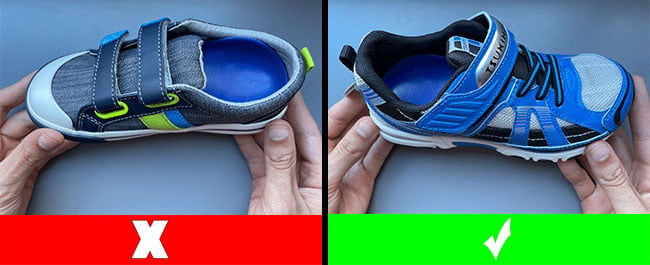
4️⃣ Shoelaces VS Velcro Closure: Shoelaces provide better support and stability compared to an alternative form of closure. I strongly suggest that you provide your child with a pair of shoelaces instead of velcro closure.
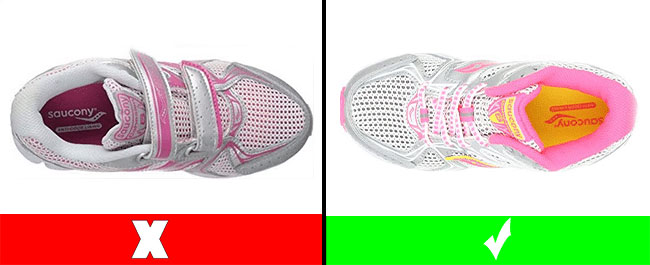
The shoes I recommend are available in different widths such as medium (M), wide (W), and extra wide (XW), so make sure that you choose your child’s foot width accordingly. Disclosure: Some links in this post may be affiliate links and we may receive a small commission (at no extra cost to you) when you click our links and make purchases.
Shoes to Help Treat Foot Drop in Children – Let’s Hold Your Child’s Feet in the Normal Position
Looking for Other Shoe Recommendations?
Do not hesitate to contact me directly at my e-mail if you rather receive specific shoe recommendations tailored to your child’s unique foot shape:
fittingchildrensshoes@gmail.com
How effective the shoes will be for your child depends on individual foot anatomy, and unfortunately there might be cases in which a doctor may recommend surgery or electrical stimulation of the peroneal nerve.
Final Thoughts on Children with Foot Drop
Sometimes foot drop is temporary, but it can be permanent. Taking a simple step can be frustrating for a child with foot drop. Helping your child feel more stable by walking and running straighter means increased function, increased confidence, increased physical activity, and increased independence!
If you believe your child is dealing with foot drop I strongly suggest that you make an appointment with your medical professional to confirm the diagnosis, so that treatment options can be explored and implemented right away. The earlier you take action, the better. I always suggest parents be proactive and don’t take the “wait and see approach” when it comes to treating their child’s foot condition. Waiting for the condition to resolve on its own can only lead to the condition getting worse and worse!
